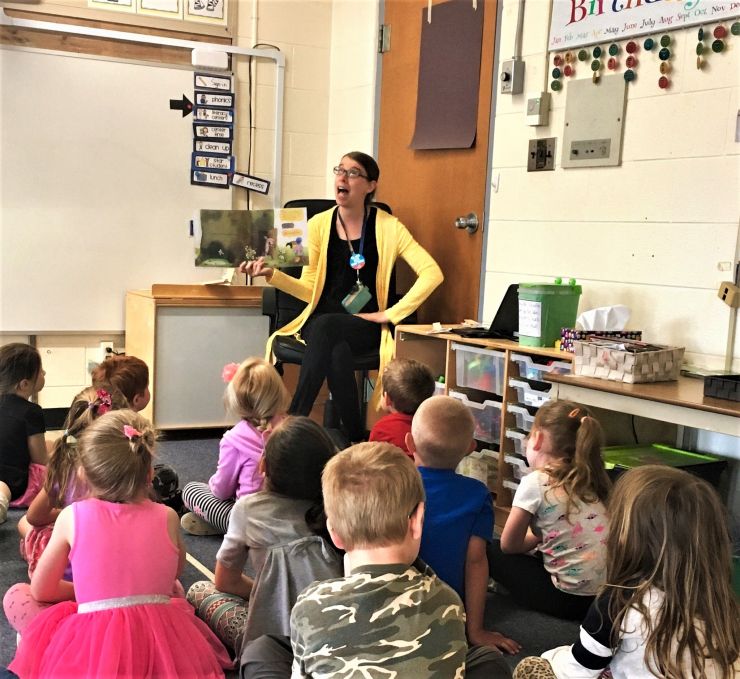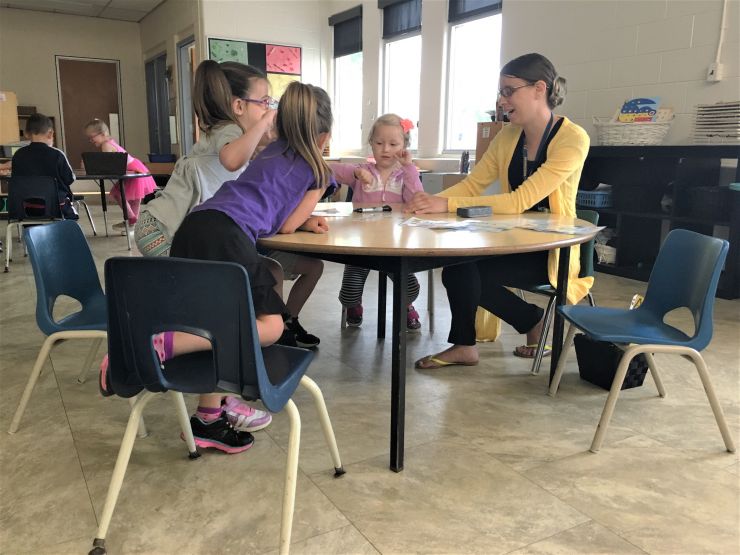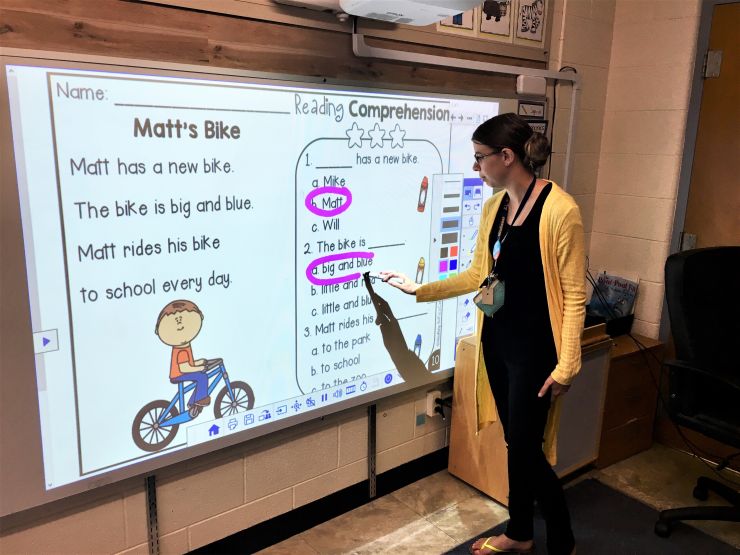On the
Job with… Courtney Smith, Early Childhood Educator

Smith is not planning to leave the Kindergarten classroom she loves, of course – the ice cream stand is imaginary. But thinking through the logistics of where the Kindergarten-student “customers” will line up, what they’ll use as currency to buy the fictitious treats, and where they’ll sit to enjoy them, requires planning and organizing behind the scenes.
“The ice cream stand is part of our dramatic centre, which changes into something new on a regular basis, and encourages playful learning where everyone has a role,” says Smith. “Some students will be responsible for making the menu and signage, others will handle the cash register, others will play the role of customers. It should be up and running by tomorrow, so they’ll be pretty excited to see things taking shape today.”
Smith is always thinking about how everyday items can be repurposed to enhance early years learning, and even though she’s been in this line of work since full-day Kindergarten was introduced in 2010, she’s still amazed at the limitless bounds of the imaginations of the four and five-year-old students in her classroom.
“I brought in some hair curlers recently and wasn’t sure what they’d do with them, if anything,” she says. “They ended up using them as building materials.”
Smith’s role is to support the learning and development of the youngest students in Grand Erie. Her classroom provides an introduction to concepts in literacy and numeracy which will prepare them for a smooth transition into Grade 1, and just as importantly, provides an engaging, welcoming space where children can gain skills that will serve them well for the rest of their lives. The days are structured with the physical, social, emotional, and cognitive needs of young children in mind, and help develop effective communication skills and the ability to cooperate, a feeling of belonging, and a healthy sense of themselves and their well-being.

“I always knew I wanted to work with children; I was the babysitter who showed up with the bucket of toys to keep them engaged and active,” says Smith, who grew up in Fisherville and attended Rainham Central School and Cayuga Secondary School before going on to Niagara College. “At this age, their imaginations and curiosities run wild, so structuring the time with their attention spans in mind is really important.”
The day is broken up into blocks of active, exploratory play at learning centres throughout the classroom, projects and activities in small groups, and whole-class lessons utilizing an interactive whiteboard that encourages participation in a fun, supportive way. Sprinkled throughout, Smith or Rowntree might put on some music and lead a “silly dance,” or put on a video where a cartoon character leads the dance moves on the whiteboard.
“There isn’t any such thing as a typical day, and the classroom is a blank slate until the children arrive and bring with them whatever has happened in their worlds leading up to that moment,” Smith points out. “There are a lot of variables – whether they had breakfast that morning or just woke up on the wrong side of the bed – so you really have to have the ability to go with the flow, providing them the freedom to explore, but with routine and structure as well.”
As early morning turns into late morning, a few students begin to feel peckish. Smith recognizes the signs instantly and sets them up with snacks to give them the energy they need until lunch. While she does this, Rowntree gets the rest of the students set up for a literacy activity that involves identifying problems and their solutions within the structure of a story.
The teaching partnership in the Kindergarten classroom is a crucial one, and throughout the day Smith and Rowntree expertly switch responsibilities so while one is leading a story time and working with students to sound out words, the other is updating agendas and setting up the next activity.

“It’s basically like a marriage, and sometimes I think we know each other better than our spouses,” Smith says of the close working relationship between early years educators. “If one of us needs something, we just have to give each other ‘the look,’ and instantly the other one knows what to do.”
In addition to that teaching partnership, the classroom itself becomes what Smith calls “the third relationship, after you and the students, and the students and each other.”
“The environment is such a huge factor in success,” explains Smith of the design thinking behind the flow of the classroom. “If you have the dramatic centre, which is high energy, next to the reading centre where students are sitting quietly, for example, it’s not going to work.”
Environment is just one of the six indicators of Grand Erie’s Multi-Year Plan exemplified in the Kindergarten room. Staff members such as Smith basically embody the entirety of the plan, promoting practices each day that help students and families feel welcomed and included, and where students can reach their full potential in an enabling space aligned to current teaching practices and learning needs.
“One of the most rewarding things about this career is developing a strong sense of trust with each student – when they have that trust in you, they feel comfortable confiding in you, and they know it’s a safe place to explore and express their emotions,” she says. “We learn together that it’s okay to be angry, but what can we do to deal with that feeling positively?”
After lunch, students return from outdoor play to a timely activity. With spring temperatures rising, a STEM lesson focused on safety in the sun has been prepared for the afternoon. Students learn about the sun’s U.V. rays, and then design and build miniature structures such as umbrellas to offer protection.
When the bell rings at the end of the day, Smith tidies the classroom space as she and Rowntree get ready for the next day.
“I’m prepared to be on my feet all day, knowing I’ll sit down maybe a couple of times, but it’s all good – it keeps me energized,” says Smith, who has a five-year-old daughter who keeps her on her toes at home as well. “Sometimes when I get home I’ll say, ‘Mommy just needs five minutes,’ because I know that’s all I’ll get!”
At the end of the day, students leave with the positivity and lessons learned during the school day, and so does Smith.
“The students teach me every day what it means to be a good friend, how to deal with emotions in a productive way, and how to make mistakes and learn from them,” she says. “I’ve also learned from them that it’s a good idea to always have a change of clothes with you in case you spill something!”
More News

